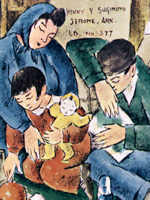The Buffalo Bill Historical Center contains several museums devoted to Buffalo Bill, Western art, the Plains peoples, and Greater Yellowstone. The Buffalo Bill Museum presents the life of W.F. Cody, better known as Buffalo Bill, and his historical context in the American West. Cody (1846-1917) operated a Wild West show between 1883 and 1913, which helped to shape popular understandings of the Western frontier. The Whitney Gallery of Western Art displays major works of Western art. Artists represented in the collection include William Ranney, T.D. Kelsey (born 1946), Edgar S. Paxson (1852-1919), and Fritz Scholder (1937-2005). The Plains Indian Museum presents the history and culture of the people of the Plains. Collection strengths include the early reservation period (circa 1880-1930), the Lakota, Crow, Arapaho, Shoshone, and Cheyenne. The Cody Firearms Museum presents the world's most comprehensive collection of U.S. firearms. The Draper Museum of Natural History presents the natural history of the Greater Yellowstone area.
All sites offer exhibits. The Draper Museum of Natural History offers interactive exhibits, audio-visual elements, monthly lectures, and an interactive elementary school educational program. The center also offers research library access and research assistance. Center educational opportunities include themed guided tours for students, traveling trunks, resource kits, videos, and teacher workshops. The website offers a Plains Indian Museum virtual exhibit and Cody Firearms Museum firearms glossary and idiom listing.
The Whitney Gallery of Western Art is closed, as the site adds interpretation, situating artworks in context.
